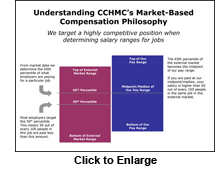
Paying for Performance
Paying for Performance takes place at the end of the performance year. Employees receive merit salary increases in line with the past year's performance. Click here to view the full timeline.
Our new approach increases flexibility for merit salary increases
Along with a new rating system, we will also follow a new matrix (shown below) to determine merit salary increases. The new matrix will give managers the flexibility they need to reward performance appropriately. Instead of a fixed increase amount (as we have with our current system), managers can select percent increases from a range. In keeping with our market based compensation approach, Individual employee merit increases will be based on the combination of:
- Individual performance rating
- Individual position in the market range
About our market-based approach to compensation

Cincinnati Children's has long had a highly competitive market-based compensation philosophy and approach. Each year we work with third-party vendors to compare the competitiveness of our pay practices to the external market. Based on what we learn, we set our compensation budget to ensure the compensation we offer is highly competitive with other market leaders.
From the information we gain, we establish salary ranges for each job. While many organizations base the midpoint of their salary ranges on the market's 50th percentile, we target the 65th percentile of the market. This means if you are paid at the midpoint of our range, you are at the 65th percentile of the external market. This helps CCHMC maintain a highly competitive market position because our ranges are naturally higher than most of our competitors in the market.
2010 Matrix for Merit Salary Increases
The following merit matrix was approved by CCHMC Leadership in early June 2010 and was used only for performance year 2010, which ended August 31, 2010. We set our guidelines for merit salary increases each year based on comparisons to the external market, and we will announce the merit matrix for performance year 2011 as we get closer to the end of performance year 2011.
Exceptional Year |
On Target |
Improvement Needed |
|
Current salary is 'above range,' or above the pay range that CCHMC has set for that job. |
The employee may receive a merit increase equal to 0.0 - 3.0 percent of his or her current salary. |
The employee may receive a merit increase equal to 0.0 - 2.0 percent of his or her current salary. |
The employee will receive no merit increase. |
Current salary is 'above market,' or above 110 percent of the midpoint of the market range for that job. |
The employee may receive a merit increase equal to 1.0 - 4.0 percent of his or her current salary. |
The employee may receive a merit increase equal to 1.0 - 3.0 percent of his or her current salary. |
The employee will receive no merit increase. |
Current salary is 'within market,' or between 90 percent and 110 percent of the midpoint of the market range for that job. |
The employee may receive a merit increase equal to 2.0 - 5.0 percent of his or her current salary. |
The employee may receive a merit increase equal to 1.0 - 4.0 percent of his or her current salary. |
The employee will receive no merit increase. |
Current salary is 'below market,' or below 90 percent of the midpoint of the market range for that job. |
The employee may receive a merit increase equal to 3.0 - 6.0 percent of his or her current salary. |
The employee may receive a merit increase equal to 2.0 - 5.0 percent of his or her current salary. |
The employee will receive no merit increase. |
Example comparing merit increase amounts in percentage terms and in absolute dollar terms
For employees who are already paid 'above range' or 'above market'. please keep in mind that although the potential percentage increases are not as great as those for employees who are 'within market' or 'below market,' the absolute dollar impact of these potential increases is still high - because salaries for those above market are already very competitive. Here is an example to explain: Let's say Laura and Kyle have the same job, and the midpoint of the market range for the job they both perform is $60,000.
|
Kyle – “On Target” |
Laura – “On Target” |
Comparison |
Kyle is paid $40,000 in a job that has a market midpoint of $60,000. He is 'below market,' and receives a percentage increase of 4% of his current pay, or an absolute dollar increase of $1600 per year ($40,000 x .04). |
Laura is paid $80,000 in a job that has a market midpoint of $60,000. She is 'above market,' and she receives a percentage increase of 2% of her current pay, or an absolute dollar increase of $1600 per year ($80,000 x .02). |
Although Kyle and Laura receive different percentage increases, their absolute dollar increases are the same. Our merit matrix helps ensure this consistency of opportunity for employees at all levels of the pay range. |
